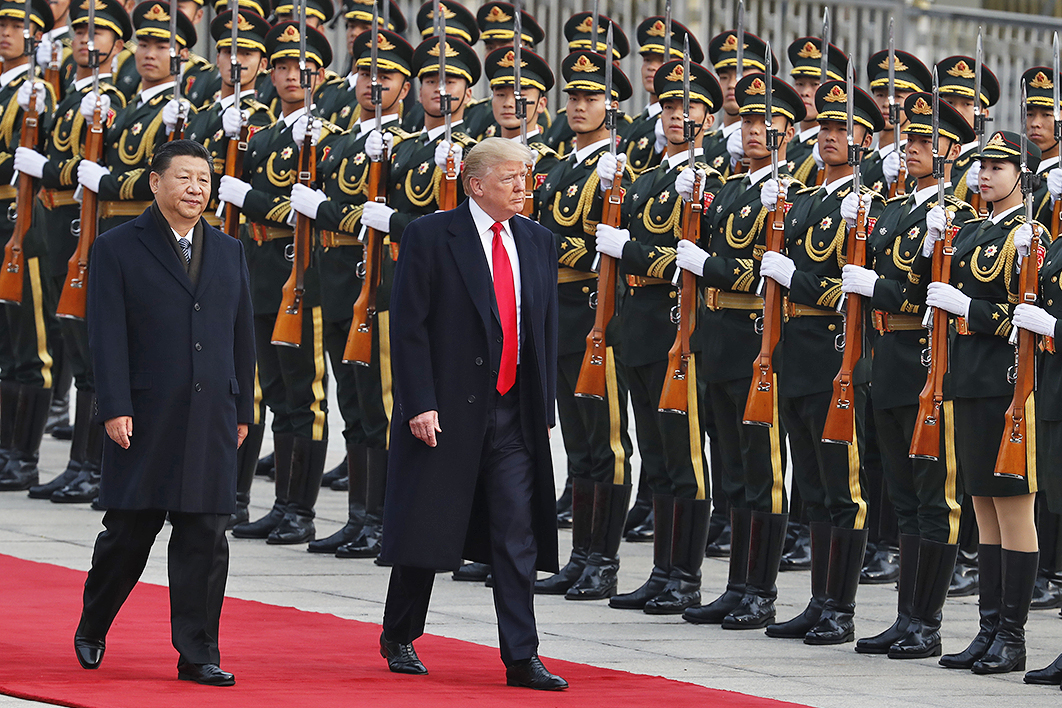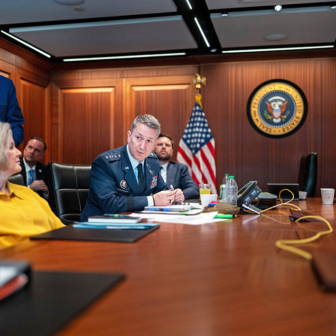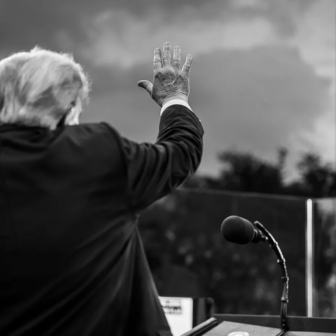Competition and confrontation build between China and the United States. The era of engagement fades; superpower rivalry returns. Great power challenges great power. The world’s biggest economy faces off with the second-biggest.
The descriptor of the moment is “new cold war” (or cold war 2.0). As a label, it’s sharp and vivid. As analysis, it’s wrong. The “new” bit is right, but it’s the newness of much of the contest that should caution against the old label.
Today’s struggle is as significant as the cold war. And it’ll run for decades. Badly bungled and dumbly driven, it could create two opposed blocs that would resemble a cold war line-up. But it’s going to need a lot more bad policy and economic stupidity to reach cold war 2.0.
What China and the United States are fighting about today is a system they share and each wants to dominate. The competition will be defined by connections and closeness. Both countries want to sit atop the system, not overthrow it.
Washington’s new fear of China was announced in US vice-president Mike Pence’s 4 October speech, which — as seen from Canberra — “sets out the most dramatic shift in relations with Beijing since Nixon and Kissinger’s ‘opening’ of relations in the early 1970s.”
Pence rails against China for its interference in everything from media to movies to markets. His description of the struggle offers an implicit rebuttal of the cold war 2.0 idea. In version 1.0, America never accused the Soviet Union of causing the US trade deficit by gaming the World Trade Organization.
Consider some other then-and-now differences.
Ideology: The cold war was a contest of ideas and values: communism fighting capitalism, Marxism versus democracy.
Today, the ideological content is almost non-existent. China isn’t offering any big new idea: it wants to expand its international power, not export its political system. The United States has a binary president, visceral in rejecting the friends, values and international institutions central to US conduct during the cold war.
The America First leader confronts the China Dream leader. The images play to the domestic audience. Neither side has much in its ideological armoury to enlist others and create a new, frigid division.
Economics and trade: The Soviet Union wanted to overthrow the economic system championed by the United States. It was Comecon versus capitalism. Bloc against bloc. Economic sphere facing economic sphere.
China merely wants to beat America at its own game. China loves what America has created; now Beijing wants to own it. From the WTO to the World Bank, China embraces the system.
Savour the irony that China, the new superpower, is following the same protectionist/mercantilist policies the United States used in the nineteenth century to match Europe. (The US civil war between the industrial north and slave-owning south was a fight between protectionists and free-traders, and the protectionists won.)
Today’s struggle between the United States and China has free-traders and protectionists on both sides. Many other nations are conflicted by this choice; Australia, more than most, wants the free-traders to win.
So, another irony: China’s leader chants the free-trade-globalisation mantra in confronting a protectionist US president.
Alliances and proxy wars: Militarily, the cold war was waged by opposed alliance systems, a hair-trigger nuclear stand-off and proxy wars.
The nukes remain, but the rest of the equation is gone. The proxy wars — Korea, Vietnam, the Soviet invasion of Afghanistan, and more — were disastrous conflicts, wounds bleeding across the second half of the twentieth century. We’re still dealing with what that did to Korea and Afghanistan. A pox on proxy wars.
The United States has allies. China doesn’t. Another irony: China understands the value of the US alliance system better than Donald Trump does.
The United States is clearly the world’s greatest military power, and US alliance dominance is a formidable bulwark against a new cold war. Yet China is coming and the equation is shifting. Robert Kaplan ponders what this means for America and its Asian allies:
The United States must face up to an important fact: the western Pacific is no longer a unipolar American naval lake, as it was for decades after World War II. The return of China to the status of great power ensures a more complicated multipolar situation. The United States must make at least some room for Chinese air and naval power in the Indo-Pacific region. How much room is the key question.
Australia and Asia need the United States as a balancer, not a new cold war belligerent.
As both the French and Chinese say in different ways, the naming of things is vital. It determines where you start and has much to do with where you go.
The trouble with the new cold war is that it’s a binary label for a networked world. The binary question last time was simple: which side of the Berlin Wall are you on? The network question is about the functions and connections of the nodes, and the protocols in use. Myriad networks, many uses. Analogue wall then; digital web now.
How will nations, acting as nodes, view the competition and the connections as well as the confrontation? No single, simple choice is possible because so many different choices crowd and call.
Strategically, the United States has enjoyed unipolar privileges since the collapse of the Soviet Union. Now, apparently, we’re to revert to bipolar business as usual, with China as the new foe. But the settings are all wrong for such a simple move. The ground today looks so different, ideologically, economically and in alliance structures.
Along with all the other disparities, today’s America is not the America of the cold war. Today’s occupant of the White House doesn’t have the intellect or worldview of an FDR or Truman or… just name your president, really. Donald Trump doesn’t do systems and structure; he does disruption and deals.
If we’re picking history analogies, look more at the long nineteenth century — from the French revolution to the first world war — than at the frigid stand-off that followed the second world war. Great power competition is back. The questions and partial answers are those of a series of contests with many different powers competing:
Q: Who you gonna trust?
A: It depends on the issue and the interests.
Q: Who you gonna line up with?
A: It depends. Everybody, or nobody, or a shifting mix.
Q: Who you gonna compete with?
A: Everybody!
Ngaire Woods gives a European-flavoured view of how this strategic free-for-all might go:
Rather than a cold war, the world may be heading toward an international system led by four powers, with the US, China, Russia, and Germany dominating their respective regions and seeking the upper hand in international negotiations. Such a scenario is reminiscent of the World War II vision of US President Franklin D. Roosevelt, who proposed that the four victorious allies — the US, the UK, China, and the Soviet Union — act as “Four Policemen,” each patrolling its own sphere of influence and negotiating with the others on world peace.
Today, approximations of the same four powers are once again in the lead, only now we have stronger international institutions to help keep the peace. Whether that peace lasts will depend on the willingness of the four powers to use and adapt those institutions to the emerging international system.
The formula looks broadly right, but too simple. And in its Asia dimension, it too easily grants China dominance.
From where Australia sits, a couple of other players must be added: India and Japan. And then there’s ASEAN, with Indonesia foremost in our calculations. As a “system,” this is more a cacophony than a concert of powers. And that brings us back to the label issue. Names matter, so let’s offer a name.
If this is not a cold war, what’s it to be called? One flippant suggestion from inside the Canberra system is “big cat spat.” It’s certainly an update of the proverb that one mountain can’t contain two tigers. The need, though, is to broaden this to suggest many mountains and many tigers.
My answer, in a phrase, is “hot peace.” In a paragraph, it’s this: Rather than a new cold war, we’re entering a hot peace of simultaneous cooperation and competition among many states. Think the heat and sweat of a great power decathlon rather than the frozen blocs and rigidly opposed ideologies of the postwar world.
“Hot peace” is a better label for what the world faces than “new cold war,” not least because we’re well short of an icy, bipolar face-off between China and the United States. Beyond the current superpower and the coming superpower, a lot of other big powers are going to matter in this new era. All those powers are going to be running in many different races. See the G20 as competitors, with lots of other nations also contending in the foreign policy version of track and field.
In the hot peace, the United States and China will be central but not always decisive. That’s because the main job of the G2 will be managing differences and divisions, not agreeing on decisions. If and when they can agree, Beijing and Washington will have the capacity to direct and dominate specific issues. Big deals, even good deals, are still possible in a hot peace.
But this era is going to make deals difficult, because competition and confrontation build as the elements of engagement fade. It will be a hotly contested peace. The argument is that we have arrived at a troubled form of peace, not a muted form of indirect war. The strategic contest will have many peaceful dimensions. Hot peace rebuts the cold war claim by saying, “We’re not there yet!”
Without getting too metaphysical, the hot idea works better in describing close partners who are simultaneously opponents. Lots of friction from all those close contacts and contests.
Rather than frigid nuclear and ideological stand-off, China and the United States are locked together, interdependent even if intemperate. Joe Nye gets it right in describing the relationship of the two giants as “cooperative rivalry.”
A former US ambassador to Moscow, Michael McFaul, calls his new book From Cold War to Hot Peace: An American Ambassador in Putin’s Russia. What McFaul sees with Russia has arrived with China. During the Soviet–US cold war, hot peace was the improved state many yearned to reach. Back in 1973, Pierre Hassner mused about that shift in the New York Times:
A new stage of “hot peace” has indeed replaced the cold war, but it would be wrong to assume that the farther one gets from war and propaganda the closer one is to peace and reconciliation. In this new state of ambiguity, situations may thaw without being solved, isolation may be broken but in favor of asymmetrical penetration or imbalance rather than of reconciliation.
One of the great American historians of the cold war, John Lewis Gaddis, notes that the cold war was fought at different levels in dissimilar ways in multiple places over a very long time. Any attempt to reduce its history exclusively to the role of great forces, great powers or great leaders would fail to do it justice. Yet for Gaddis, the first step to understanding is clear: “It is worth starting with visions, though, because they establish hopes and fears. History then determines which prevail.”
If the many competitors stuff up this new era, they could freeze the hot peace and drive history to deliver us all to a cold war. •




